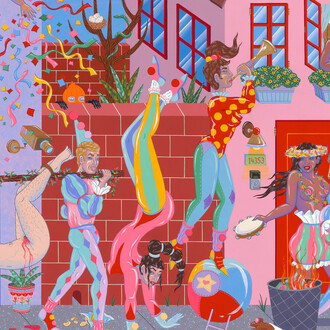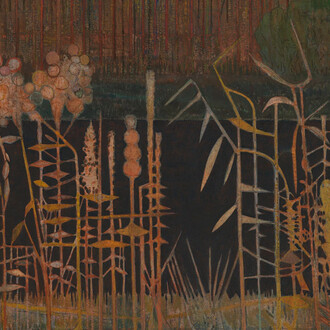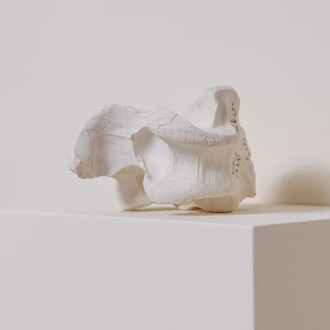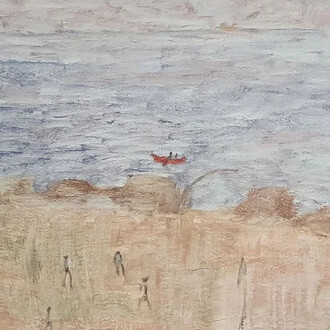The Hole is proud to present My Inner Demon Never Sleeps Alone, a body of work that Matthew Hansel has been developing over the course of the last three years.
The main gallery features a bestiary of demons, pixies and nude men and women in all kinds of entanglements, poses and rituals. The human figures are painted from clippings from 1960s and ‘70s brochures for West Coast nudist colonies, while their demons, with scaly bodies, attenuated snouts and poulaine-toed feet, recall the morality paintings of Hieronymus Bosch. Hansel’s allegorical twist: instead of admonishing the viewer, he aims to enchant them, conjuring a universe in which, he says, “people are able to live beside and enjoy their demons in a way that they can’t in the real world.”
It’s in our unattended moments that we allow ourselves the freedom to contemplate the abject. We allow ourselves to flirt with our demons; to be seduced by them. Pursuant to this point, the critic Pear Salabert wrote, “The redemption of the flesh through the raw materiality present in art can lead the spectator to a state in which his physical or moral integrity is altered. The abject is the process, always in transit, which dominates the obscene instance of the object. That’s why the subject is drawn to it, instead of rejected, in a sort of ‘seductive disgust.’
It is this transitional state between disgust and delight, pleasure and refusal, Eros and Thanatos that makes the grotesque so intoxicating. Art persuades us of its beauty and allows us to delight in the paradox. It’s this paradoxical world that I am most interested in. Where the freedom exists to fall in love with the unlovable and seek the unknowable. A place where one can eschew the coldness of classical beauty and indulge guilt free in the allure of the repulsive. A hinterland where you can happily live alongside your demons—or at least date them for a while.
(Matthew Hansel)
The rear gallery contains five oil and flashe works that Hansel describes as meditations on color and 20th century abstraction, each of them filled with the precisely painted knots, fringes and folds of rumpled oriental carpets. Lavishly topographic, their titles—A Patterned Promised Land (Red), The Unfolding of Wrinkle Ridge (Pink), Midnight on Modest Mountain (Blue), The Crease In Desert Canyon (Yellow) and Moonlight on Moss Covered Cliffs (Green)—refer to landscapes, the carpets’ undulations suggesting mountains, caves and valleys.
Hansel’s inspiration for the series came while visiting the Metropolitan Museum of Art as a student: he saw A Maid Asleep, Vermeer’s depiction of a young woman nodding off next to a glass of wine, a composition that is dramatically interceded upon by a 17th-century Anatolian Kilim rug draped across a table in the foreground. The imported textile is a common yet normally subtle element in depictions of Dutch upper class interiors of the time. Hansel was transfixed by the Vermeer: “there’s this beautifully painted rug,” he remembers, “and I thought: that rug is enough for the whole painting.”
Rounding out the show in the west gallery is Hansel’s first-ever series of drawings, each of them seemingly a study for a staffage painting in flashe paint and colored pencil on paper. As in his large canvases, demons and humans are engaged in some baffling and surreal kind of recreation. A person’s head sprouts a windmill or a crop of mushrooms, bouquets and trumpets emerge from butts, and a chimera on roller skates pauses to concentrate on a task that’s much better seen than described.
Matthew Hansel (b. 1977) holds an MFA from Yale University and BFA from The Cooper Union School of Art. This is his third solo exhibition with the gallery, following Inner Demon Delectatio in 2021 and Giving Up the Ghost in 2019. He has had other solo exhibitions in Milan, London, Tokyo, Detroit and Culver City and has shown at Brand New Gallery, Galerie Droste, PM/AM among many others.
















